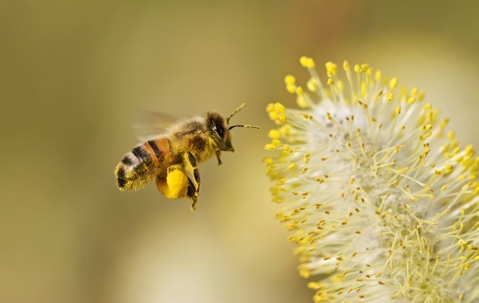How Do Bees Fly?
Bees are remarkable fliers, and their ability to take flight has fascinated scientists for years. The mechanics behind bee flight are unique, and they employ a different technique compared to many other flying insects or birds.
Bees have two pairs of wings: a larger forewing and a smaller hindwing on each side of their body. These wings are not rigid but flexible and can move independently of each other, which allows bees to execute highly controlled movements during flight.
How Bees Generate Lift and Fly:
Wing Motion: Bees flap their wings at an incredibly fast rate, around 200-300 times per second, depending on the species and the activity they are performing. This rapid wing movement helps generate the lift necessary for flight.
Wing Rotation: Rather than simply moving their wings up and down, bees perform a unique motion called figure-eight wing movement. This technique involves rotating their wings in a way that creates both vertical and horizontal forces. The wings generate lift not only from the downstroke but also from the upstroke. This is unlike other insects, which typically generate lift only from their downstroke.
Airflow and Lift: The unique wing motion creates vortices (whirlpools of air) above the wings that help generate additional lift. This phenomenon is a key part of how bees can stay aloft despite their relatively large body mass compared to their wing size.
Muscle Control and Flexibility: Bees have specialized muscles that control their wing movements, and these muscles allow for fine adjustments in flight. The indirect flight muscles of bees contract and expand to move their wings, and these muscles are incredibly efficient for rapid wingbeats.
Small Size and High Metabolism: Bees' small size and high metabolism play a role in their ability to maintain flight. The energy required to flap their wings at such a fast rate is provided by the bee’s high metabolic rate. Their bodies are adapted to convert nectar and pollen into the energy needed for flight.
Control of Flight: Bees are capable of highly precise movements, enabling them to hover, maneuver around flowers, and navigate complex environments. This control is crucial for tasks such as collecting nectar, avoiding obstacles, and returning to their hive.
Bees’ ability to fly is due to the combination of rapid wingbeats, efficient muscle use, flexible wings, and intricate control of airflow around their bodies. Their flight mechanics are so efficient that they can hover in place, change direction quickly, and navigate with remarkable accuracy.
Can Bees Fly At Night?
Bees generally do not fly at night. They are diurnal creatures, meaning they are active during the day when it is light. There are several reasons why bees typically avoid nighttime flight:
Vision: Bees rely heavily on their excellent vision to navigate, especially when foraging for nectar and pollen. They have specialized compound eyes that allow them to see ultraviolet light, which helps them locate flowers. At night, in the absence of light, their ability to see and navigate is significantly reduced, making it much harder for them to fly or find food.
Energy Conservation: Flight requires a lot of energy, and bees need to forage during daylight hours to gather the energy-rich nectar they use for fuel. At night, most bees are resting in the hive or sheltering to conserve energy for the next day's activities.
Temperature: Bees are ectothermic, meaning their body temperature depends on the environment. At night, temperatures can drop significantly, and colder temperatures can impair their flight ability. They need to maintain a certain body temperature for their muscles to function properly during flight.
Exceptions:
While bees are typically not active at night, there are some exceptions:
Night-flying species: A few species of bees, like the night bee (also called nocturnal bees), have adapted to fly during the night. These bees are more active in low light conditions, usually around dusk or in the dark hours, and they have better adaptations for nocturnal activity.
Artificial lighting: In areas with artificial light, some bees might be attracted to lights at night, especially if there are flowers or food sources nearby that they are drawn to.
However, most bees in general will avoid flying at night and are primarily active during the daylight hours, when conditions are more favorable for their foraging and navigation.

